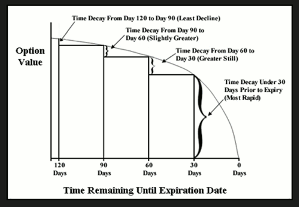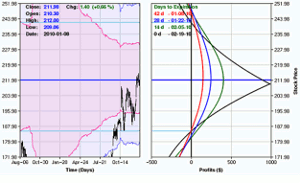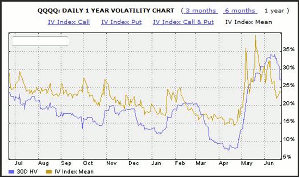Option trader A.J. Brown of tradingtrainerblog.com points out some potential pitfalls of trading at-the-money calendar spreads, which could trap unwary traders.
Over the years of being both an options trader and trainer, I have seen different option strategies that come into and out of vogue. It seems almost cyclical, like fashion.
For me, every option strategy has its time and place to be traded. I look at each option strategy as a tool for an application. Rather than trying to apply a single tool to every situation, I prefer to assess the situation and pick the right tool.
With that said, I am seeing a lot of emphasis right now on at-the-money (ATM) calendar spreads. I thought it would be worthwhile to show some insights and bring attention to some hidden gotchas that, if not accounted for, could turn a highly profitable ATM calendar spread into a big loser.
First, what are ATM calendar spreads? ATM calendar spreads are sometimes called ATM time or ATM horizontal spreads. They are constructed by buying an at-the-money option with an exercise or expiration date farther out-in-time. Then, selling an at-the-money option (with the same exercise or strike price as the option bought) with an exercise or expiration date closer-in-time. They can be constructed with either put or call options. The idea is to profit on an underlying stock that is channeling horizontally by capitalizing on the difference between the rates of option time decay.
The image below shows that the closer to expiration an ATM option gets, the faster the rate at which the option value changes.
Time Decay Table
The ATM calendar spread profits based on the difference between the rates of time decay of the option bought that expires far out in time versus the option sold that expires closer in time.
ATM calendar spreads profit, at first glance, so long as an underlying stock stays within a certain range. The image below shows an example of an underlying stock’s price chart to the left and an ATM calendar spread’s profit and loss diagram to the right.
Stock Price vs. Calendar Spread Theoretical Charts
The gotcha associated with ATM calendar spreads is that an investor might not factor in the effects of implied volatility changes (option traders call this the “vega risk”). I’ve looked over the shoulder of some ATM calendar spread traders, and have been surprised, if not alarmed, that they’ll factor in the underlying stock price range and the difference in time between the two options and leave it at that.
Implied volatility is a factor in an option’s price. The higher the volatility is, the higher the option price will be. Higher implied volatility develops because the market expects a big move on the underlying stock price either up or down. Let me emphasize that volatility does not predict direction or even specify that a directional move will happen, it is just the expectation of how far a potential move could take that stock price.
NEXT PAGE: Implied Volatility: The Secret Sauce
|pagebreak|The image below shows an example plot of implied and historical volatility over a year period.
Implied & Historical Volatility Chart
It turns out that even though our primary focus for profiting from an ATM calendar spread is the difference in option time decays, the strategy is actually much more sensitive to changes in volatility.
An increase in implied volatility will cause a “volatility rush” in the ATM calendar spread, causing the amount of profit to grow and the range that the underlying stock must stay within to profit, to be larger. These are both good things.
Conversely, a decrease in implied volatility will cause a “volatility crush” in the ATM calendar spread, causing the amount of profit to shrink and the range that the underlying stock must stay within to profit, to be smaller. These ramifications are not good at all and can actually take a potential winning trade and make it a loser.
When investors look for underlying stocks to trade ATM calendar spreads on, they look for those that they expect to trade in a narrow range for the next 30 to 45 days. The gotcha is if they stop there. It’s imperative that they also evaluate implied volatility.
Because implied volatility has a tendency to revert back to its mean, I advise to look for implied volatility to be in the lower 25% of its yearly range. I also recommend comparing the implied volatility of the two options being considered for the ATM calendar spread. If anything, you want the option you sell that is closer-in-time to have a higher implied volatility than the option you buy that is farther out-in-time. This is called having a positive implied volatility skew.
By assessing implied volatility and implied volatility skew, an ATM calendar spread trader can set themselves up for not only profiting, but also potentially realizing a “volatility rush” that will only add probability of an increase to their winning.
In summary, ATM calendar spreads are trades that have a high profit probability and a favorable reward-to-risk. However, if the trader does not factor in changes in implied volatility when considering the trade, a calendar spread that seems a dream at the time the trade is being considered, may turn into a nightmare as the trade progresses along.
Keep doing ATM calendar spreads, but be sure to analyze the implied volatility. Specifically, trade calendar spreads with low historical volatility at the time the trade is being considered and look for positive implied volatility skew.
A.J. Brown can be found at tradingtrainerblog.com.





















